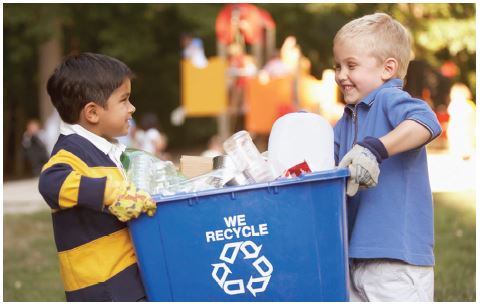Written on: June 1, 2023 by Nicholas Georges
My three-year-old niece has a fascination with recycling and recycling trucks. Not garbage trucks, because those are stinky; no, she loves the green recycling trucks that come down the street once a week. According to my other friends with young children, this is common, which leads me to believe that Generation Alpha cannot get enough of trips to waste sorting facilities, recycling trucks and can collection machines.
I’m not sure where this interest comes from, but I think we can all agree that educating our youth about the importance of recycling is important. However, what should we teach them? There are still many questionsi about what products and materials we should recycle and how. Should consumers bag their recyclables? Can grocery bags and plastic wrappers be recycled? How are materials sorted after a consumer puts them in their curbside program? Furthermore, as my niece regularly asks, when do the magical green trucks come?

Plastics have become the “poster child” for confusing recycling rules. Many people think a plastic is recyclable when they see the chasing arrows symbol (accompanied by a number) on the packaging, but that number is actually used to identify the type of resin plastic, which makes it easier to sort out materials to be recycled. Therein lies the problem.
In an attempt to provide clarification, California passed SB-343, Environmental Advertising: Recycling Symbol: Recyclability: Products & Packaging.ii Other efforts to address confusion related to recycling are underway, but accordingiii to the United Nations Environment Programme (UNEP), only an estimated 9% of all plastics have been recycled. That means there’s still work to be done. The UNEP has established an Intergovernmental Negotiation Committee (INC) that is responsible for developing a plastics treaty. However, to do this effectively, it’s essential to understand the technology involved in recycling plastic products, packaging and material.
There are two main processes for recycling plastics that work in tandem—mechanical recycling and advanced (or chemical) recycling. Mechanical recycling breaks up plastic material, either by crushing, grinding or some other physical means to break down the material, which is then remelted into granules that can be used to create new products. Mechanical recycling is more common than advanced recycling because it’s what our current infrastructure is set up to handle. It is important to note that, for mechanical recycling, materials must first be sorted because it requires an uncontaminated waste stream and can only handle certain types of plastic. Mechanical recycling cannot be used on multilayer plastics because the process weakens the strength of the plastic, limiting the number of applications the recycled resin can create.
Advanced recycling is a newer technology for recycling plastics and is actually multiple technologies, such as enzymatic hydrolysis, methanolysis and glycolysis. These processes are used to break down plastic waste, which can then be used as a feedstock to manufacture new products by breaking down the polymer chains into monomers that can be used again to build new polymers. This process can remove contamination and produce chemicals with the same quality and physical properties as virgin material. Advanced recycling is more energy intensive than mechanical recycling and should be used as a complementary technology and not as a substitute, but it’s betteriv than virgin plastic production and can divert plastic that is unsuitable for mechanical recycling from incineration, landfills or the environment. Advanced recycling is currently limited in scale, but several companies in the European Union and the U.S. have made significant investments in this technology to develop and scale it for the future.
Our society has a diverse range of plastic materials and packaging, and it isn’t practical to think one single solution can manage all of that material. Public policy should encourage the development and advancement of new technologies to help recycling streams become more efficient and effective. Through these technological advances, we can produce more recycled resin to meet the needs of consumers and workers who depend on plastic.
Education on how to properly recycle is just as important as achieving these technological advances. Recycling correctly and minimizing contamination are essential to ensuring that plastic and other materials can be recycled into new products. The goal is to build a solid foundation for recycling so that future generations, whether that’s my niece’s generation or the generations that will come after, can focus on other issues rather than continue to address the shortfalls of turning our garbage into the products of the future.
For further information, please contact me at ngeorges@thehcpa.org. SPRAY
i link
ii link
iii link
iv City College of New York. “Advanced plastics recycling yields climate benefits.” ScienceDaily. ScienceDaily, 12 October 2022.